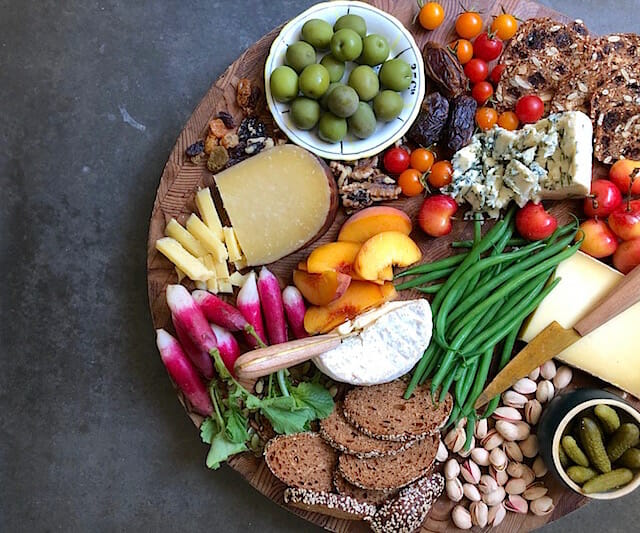Most of us think of a cheese plate as something to pull together when company comes. Nutrition isn’t typically top of mind, since cheeseboards are often a special occasion treat more than an everyday affair. But the truth is, there’s no reason that, done right, you can do up a healthy cheeseboard as a solution to weeknight supper, as well as something to pull out for a party. It’s a snap to do and ideal this time of year when temperatures rise and switching on the stove isn’t so appealing.
A Colorful, Flavorful, Nourishing Cheeseboard
The key to a fabulous cheese plate is balance. I like to start with an assortment of good California cheeses and build from there. It can be tempting to look further afield for cheese, but the fact is (particularly for those of us living in the West) California is far more local than what gets shipped from across the country or overseas. And let’s not forget that cheese is a fermented food and a rich source of nutrition. Just one little ounce delivers 20 percent of your daily needs for calcium along with a meaningful dose of protein.
Once you’ve got your cheeses, creating an everyday cheeseboard supper is a matter of adding in plenty of other whole foods, particularly vegetables, fruits, and whole grains. The end result? A beautiful and balanced plate.
How to Make a Colorful Cheeseboard, Step-by-Step:
-
Choose your Cheese
Select between two to four cheeses, depending on how many are in your crew, and vary them by taste and texture. Pictured here are four California cow’s milk cheeses that range from a mild washed rind triple creme to a sharp and tangy blue. If you’re buying cheeses with the Real California Milk Seal, you can bet they’re made with milk from a family farm, since 99 percent of dairies in the state are just that: family-owned. And if you’re lactose sensitive, not to worry. Natural hard cheeses such as Cheddar, Jack, and Gouda, and soft-ripened cheeses such as Brie and Camembert, have little to no lactose.
-
Add Seasonal Vegetables
A variety of vegetables work well on a cheeseboard and make a crisp counterpoint to the creaminess of the cheese. Here I’ve chosen radishes, cherry tomatoes, and blanched green beans. Other favorites include raw fennel, carrots, celery, kohlrabi, and cucumbers. I also recommend roasted vegetables of every stripe. (And don’t be shy about adding volume; be generous with the veggies)
-
Fill in with Fruit
Choose what looks good to you and is ideally in season. Melon, stone fruits such as peaches and nectarines, grapes, apples, pears, berries of all kinds, pomegranate, and persimmons are all excellent options. They add a pop of color and go particularly well with blue cheeses and soft, creamy ones, too.
-
Choose Nuts, Seeds, and/or Dried Fruit
Nuts and seeds add crunch along with healthy fats. Dried fruits go beautifully with a huge variety of cheeses and are a source of fiber. Choose what you love and go easy. Nuts and dried fruits are good for you, but concentrated in calories.
-
Include Pickled and Cured Favorites
The likes of olives, cornichons, and pickled vegetables are a cheeseboard must in my book. Raid the olive bar at your local supermarket for an assortment of choices.
-
Finish with Quality Breads and Crackers
Emphasize whole-grain crackers and breads on your cheeseboard for more fiber and staying power. If you have gluten-free folks in your midst, there are plenty of options in the cracker aisle. If you have a few spare minutes, brush slices of whole grain baguette with a little olive oil and blister them on a grill or in the toaster.
Also, if you want to include a few condiments, consider coarse-grain mustard, honey, chutneys, jams, and quince paste to all be fair game.
-
- Pull out a large plate, platter, or cutting board to use as the foundation for your board. Smaller is better in my book, since an abundant-looking spread is hard to resist.
-
- Lay all your goodies on the board. Put olives and pickled goodies in little bowls.
-
- Set out knives to cut the cheeses.
-
- Make it easy on everyone by pre-slicing some of the harder cheeses and crumbling blue cheese so it’s easy to grab.
- Arrange a stack of small plates and napkins and invite everyone to dig in. Supper is served.
Look for the Real California Milk Seal and head here for a product locator.
